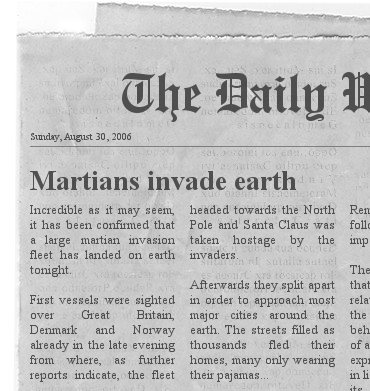Science Communication Seminar
EEB 5894 (NOT Dr. Likens's seminar -- that's different. Sorry.)
Faculty:
Margaret Rubega, EEB; Kent Holsinger, EEB; Ken Noll, MCB; Bob Wyss, Journalism
This page lists weekly meetings of the Seminar in Science Communication. This semester (Fall 2008) we will be reading and discussing science reporting in the New York Times. If you need a permission number, please contact Margaret Rubega.
Meeting time: Thursdays 2 - 3 p.m.
Location: NOTE THAT THE ROOM HAS CHANGED (again, but hopefully for the last time) to TLS 263.
Required Reading:
You should arrive every week having read the preceding Tuesday’s Science Section in the New York Times, and ready to discuss it. You have several options for access to the NYT: You can use the order form to order a personal subscription OR You can pick up a FREE copy of the paper at selected locations on campus, as long as you arrive before the free copies are all gone OR You can read the paper FREE online.
Expectations for Students
READING: We would like you to read the articles in the Science section critically, assessing the quality of articles from the point of view of:
Accuracy: does the article say things you know or suspect to be wrong?
Evidence: is there sufficient evidence presented for you to believe the conclusions drawn by the reporter?
Balance: does the reporter consider alternative explanations? Are experts from all sides of an issue interviewed and quoted?
Clarity: how hard is it to understand the article? Pretend to be your grandmother while thinking about this one!
Newsworthiness: why did the reporter decide to focus on this story? Why did the editor run it? How likely it that the information presented will change policy/technology/behavior/the world?
PRESENTATIONS: Every student will be expected to present an analysis of a news article to the rest of the group at least once. Students should pick an article, read it, then investigate the background of the story in the primary scientific literature. Read the technical paper that prompted the story, at least. Reconsider all issues listed above; your presentation should address how good a job the reporter did achieving accuracy, balance, and clarity. Your presentation should also address what the scientist did, or could have done, to increase the chances that the reporter would produce an accurate, clear, engaging story.
Given the level of enrollment, and the limited number of weeks for presentation, at least some students will have to present in pairs. Presentation partners should consist of graduate/undergraduate pairs; NO undergrad/undergrad or grad/grad pairs. Talk to Margaret if you would like to present with a partner and you aren't sure how to secure one.
Discussion Schedule
| Week of: | Who | Topic | Notes | ||||
|---|---|---|---|---|---|---|---|
| 28 Aug | M.Rubega | Class intro: organization. | Come prepared to introduce yourself | ||||
| 4 Sep | Bob Wyss | Science communication from the journalist's perspective | : | ||||
| 11 Sep | Brian Hiller | Article on nitrogen effects from last week's paper. | Supplemental reading (for those with the time and the will: the Nature paperthat stimulated the news piece, and a link to another technical article on nitrogen, and LOTS of other supplemental resources from Science. | ||||
| 18 Sep | Sarah Treanor | Carl Zimmer article on "Friendly Invaders" from 9/9/08 | the PNAS paperthat stimulated the news piece | ||||
| 25 Sep | Laura Cisneros | "A cold stare can make you crave some heat" By Benedict Carey from 9/16/08 | copy and paste the link below in order to see the scientific paper (Zhong C. and G.J. Leonardelli. 2008. Cold and lonely. Journal of Psychological Science) in which the Times article was written on [www.psychologicalscience.org/journals/ps/19_9_inpress/ZhongRR.pdf] | ||||
| 2 Oct | Carrie Fyler & Julia Otero | "Historical DNA analysis reveals living descendants of an extinct species of Galapagos tortoise" from: A Tortoise May be Bred Back Into Being. New York Times 9/23/2008 | This link will take you to the PNAS Website where you can download a PDF of the original paper. It is a short paper and will help the discussion if you read it before Thursday's class! | ||||
| 9 Oct | Tanner Steeves & Kevin Burgio | "Applying Science to Alternative Medicine" NY Times 9/30/08[1] | Please take a few minutes to explore the National Center for Complementary and Alternative Medicine's website:[2]. And check out this article that offers criticism:[3]
[|- |
16 Oct | Andrew Lagasse & Adam Wilson | ||
| 23 Oct | |||||||
| 30 Oct | Lyndsey Tanner | ||||||
| 6 Nov | Brian Klingbeil | ||||||
| 13 Nov | Yannawan Wongchai | ||||||
| 20 Nov | Leroy Robinson | ||||||
| 27 Nov | XXXXXXXXXXXXXXXXXXXXX | NO MEETING: THANKSGIVING | |||||
| 4 Dec | Chiron Otero |
Related Reading
This space is for posting links to readings of interest external to the NYT. Students may consider leading a discussion on materials in the list below; if you wish to use one of these, get approval from Margaret first. Students using pieces not drawn from the list below should be sure to warn the rest of the group well in advance, so everyone has a chance to read the relevant piece in time.
The Washington Post's "GREEN: Science. Policy. Living." page, online.
A report on evidence of media bias from Scientific American
Peter Vitousek's 1994 MacArthur Lecture on Ecology and Global Change, wherein he notes that we are not doing a very good job of communicating our evidence to the public. Uh, yeah.
The first of two-part piece from the Columbia Journalism Review on Public Opinion and Climate Change
Part Two of the CJR Public Opinion and Climate Change piece.
Governor Palin's stance on teaching creationism in the classroom From the Anchorage Daily News, this ran during the last gubernatorial race in AK.
